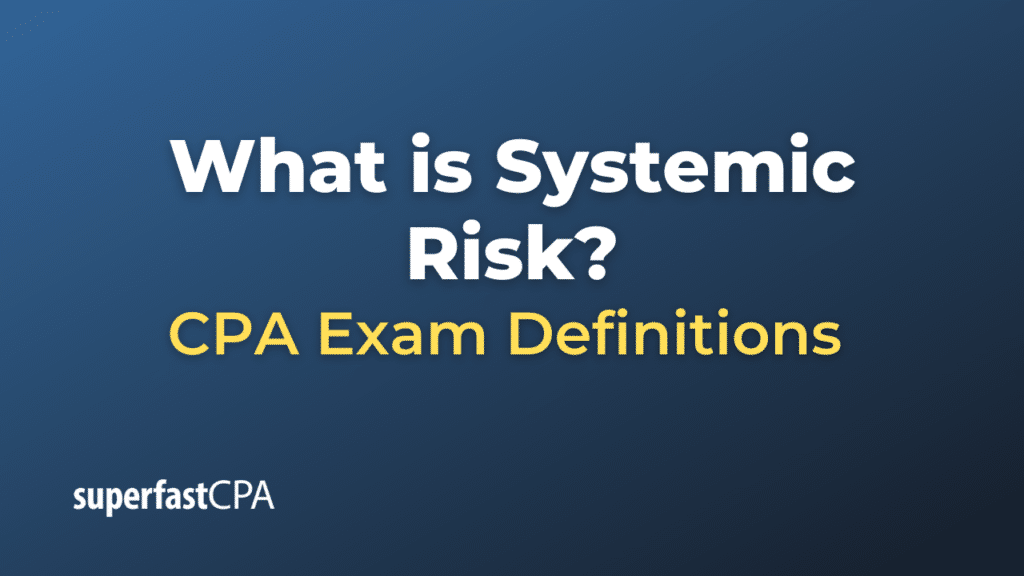Systemic Risk
Systemic risk refers to the potential for a disruption in the financial system, typically initiated by an event at a company, sector, or market level, which then causes a ripple effect of negative impact across the broader economy. Essentially, it’s the risk of a major failure of a financial system, whereby a crisis occurs when providers of capital lose trust in the users of capital.
In other words, systemic risk concerns the collapse of an entire financial system or entire market, as opposed to the collapse of a single entity or group of entities (which is known as “idiosyncratic risk”).
Causes of Systemic Risk:
- Interconnectedness: Financial institutions are often connected in complex ways. If one significant institution fails, it can create a domino effect.
- Liquidity Issues: If entities massively withdraw their money, it can lead to a liquidity crisis.
- Market Panic: Sudden panic can cause massive sell-offs in the market, leading to sharp declines in asset prices.
- Operational Failures: This can range from human errors to system breakdowns.
- Macro-Economic Factors: Economic factors such as inflation, recession, or currency crises can contribute to systemic risk.
Examples of Systemic Risk Events:
- 2008 Financial Crisis: The collapse of large financial institutions due to exposure to subprime mortgages, compounded by bailout refusals by the national governments, led to sharp drops in consumer wealth, severe disruptions in financial markets, and a downturn in economic activity. This crisis is often cited as a classic example of systemic risk materializing.
- Dotcom Bubble: The late 1990s saw a rapid rise in U.S. equity valuations fueled by investments in internet-based companies. However, many of these companies crashed, leading to panic and a broader market downturn.
Mitigation: Central banks and other regulatory bodies try to reduce systemic risks through regulatory frameworks, supervision, and sometimes interventions. The aim is to ensure transparency, reduce the level of risk taken by financial institutions, and ensure that institutions have adequate capital to sustain shocks.
In sum, systemic risk pertains to the potential for widespread financial or economic upheaval due to disruptions in the normal functioning of financial institutions or markets.
Example of Systemic Risk
Let’s delve into one of the most notable examples of systemic risk: the 2008 financial crisis.
Systemic Risk Example: The 2008 Financial Crisis
Background: The 2008 financial crisis began with the bursting of the United States housing bubble. Leading up to the crisis, there was an increase in housing prices, prompting banks and other financial institutions to give out more and more loans, including to individuals with questionable creditworthiness (often referred to as “subprime mortgages”).
Many of these mortgages were bundled into mortgage-backed securities (MBS) and sold to investors. These securities were then rated highly by credit rating agencies, making them appear safer than they actually were.
Trigger: As interest rates began to rise and housing prices started to drop, many homeowners found themselves unable to meet their mortgage payment obligations. This led to a significant increase in home foreclosures. The mortgage-backed securities tied to these mortgages began to fail, leading to huge losses for the investors who held them.
Domino Effect:
- Banks and Financial Institutions: Institutions like Lehman Brothers, which had significant exposure to these bad securities, faced massive losses. Lehman’s bankruptcy in September 2008 marked one of the largest in history and was a significant trigger for the global financial crisis.
- Interconnectedness: Financial products and derivatives linked various institutions. When one institution faced problems, the ripple effects spread to others. The uncertainty regarding the actual value of assets held by banks led to mistrust, causing banks to become wary of lending to each other.
- Global Impact: The crisis wasn’t limited to the U.S. Due to the interconnected nature of the global economy, financial institutions worldwide felt the repercussions. Markets around the world plummeted.
- Economic Recession: The financial turmoil led to a full-blown economic recession, with businesses failing, unemployment rates soaring, and consumer spending plummeting.
Government Intervention: To combat the crisis, governments around the world, including the U.S., took unprecedented steps. This included massive bailouts for banks and other financial institutions deemed “too big to fail,” slashing interest rates, and implementing economic stimulus packages.
The 2008 financial crisis is a textbook example of systemic risk where a problem in one segment of the economy (the housing market) led to widespread collapse across multiple sectors and countries. The crisis highlighted the interconnectedness of modern financial systems and the potential dangers posed by complex financial products that are not well-understood even by those investing in them.













